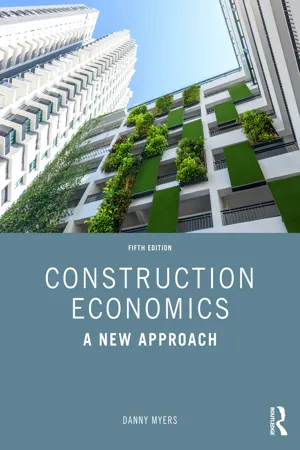
- 356 pages
- English
- ePUB (mobile friendly)
- Available on iOS & Android
About this book
Construction Economics provides students with the principles underlying the relationship between economic theory and the construction industry. Its new approach specifically examines the problems of securing sustainable construction and this fifth edition broadens the message to address the immediacy of the problems relating to the carbon-based world that we have constructed.
Embracing the whole process of the construction life cycle, the new edition discusses the economic impact of the Covid pandemic on the industry and the broader implications of the promise to build back better. It also includes new coverage of the opportunities offered by technology, the establishment of higher standards to achieve greater energy efficiency and wellbeing, the adoption of the principles of a circular economy, the retrofit of existing buildings and the recycling of materials. New sections also highlight the methodology of the subject to identify the boundaries of construction economics and clarify what to expect and what can be achieved.
As with previous editions, it retains a tried and tested format including:
- a clear and user-friendly style
- use of colour for emphasis
- regular summaries of key points
- a glossary of key terms
- extensive use of tables, figures and data
- readings from Construction Management and Economics
- tutorial questions to review each section
- research guidance
- reviews of useful websites.
This invaluable textbook is essential reading across a wide range of disciplines. It provides the economic context to the relevance of sustainability and debates about climate change, highlighting the vital contributions that surveyors, contractors, project managers, engineers, architects and developers can offer to take it forward.
Frequently asked questions
- Essential is ideal for learners and professionals who enjoy exploring a wide range of subjects. Access the Essential Library with 800,000+ trusted titles and best-sellers across business, personal growth, and the humanities. Includes unlimited reading time and Standard Read Aloud voice.
- Complete: Perfect for advanced learners and researchers needing full, unrestricted access. Unlock 1.4M+ books across hundreds of subjects, including academic and specialized titles. The Complete Plan also includes advanced features like Premium Read Aloud and Research Assistant.
Please note we cannot support devices running on iOS 13 and Android 7 or earlier. Learn more about using the app.
Information
1 An Introduction to the Basic Concepts
| The key actors include: |
| ✓ Suppliers of basic materials, such as sand, cement, aggregate and bricks |
| ✓ Manufacturers of site equipment, such as cranes and bulldozers |
| ✓ Manufacturers of components, such as windows, doors, pipes and radiators |
| ✓ Site operatives who bring together components and materials |
| ✓ Project managers and surveyors who coordinate the overall assembly |
| ✓ Architects and engineers who design new buildings and infrastructure |
| ✓ Facility managers who manage and maintain property |
| ✓ Property developers who initiate new projects |
| ✓ Providers of complementary services, such as demolition, disposal and clean-up |
| Parties involved in supply | Responsibilities |
|---|---|
| Architects and Designers | Provide specialist advice concerning structural, electrical, mechanical and landscape details. Identify key specifications. |
| Project Manager | Manages project in detail. Liaises between the client and the construction team. |
| Cost Consultant | Prepares bills of quantities, cost plans, etc. |
| Main Contractor | Manages work on site. |
| Subcontractors | Supply specialist skills. |
| Suppliers | Provide building materials and components. |
| Areas of construction | Examples of type of work |
|---|---|
| Infrastructure | Water and sewerage Energy Gas and electricity Roads Airports, harbours, railways |
| Housing | Public sector (e.g. housing associations) Private sector (e.g. new estates) |
| Public non-residential | Schools, colleges, universities Health facilities Sports and leisure facilities Police and fire stations |
| Private industrial | Factories Warehouses Oil refineries |
| Private commercial | PFI (and similar public private partnerships) Schools/hospitals (where privately funded) Restaurants, hotels, bars Retail (outlets and shops) Offices |
| Repair and maintenance | Extensions and conversions Renovations and refurbishment Planned maintenance |
INTRODUCING CONSTRUCTION ECONOMICS
the value of the alternative forgone by choosing a particular activity.

Table of contents
- Cover Page
- Half Title Page
- Title Page
- Copyright Page
- Table of Contents
- Introduction to the Fifth Edition
- Chapter 1: An Introduction to the Basic Concepts
- Part A Effective Use of Resources
- Part B Protection and Enhancement of the Environment
- Part C Economic Growth that Meets the Needs of Everyone
- Glossary
- References
- Index